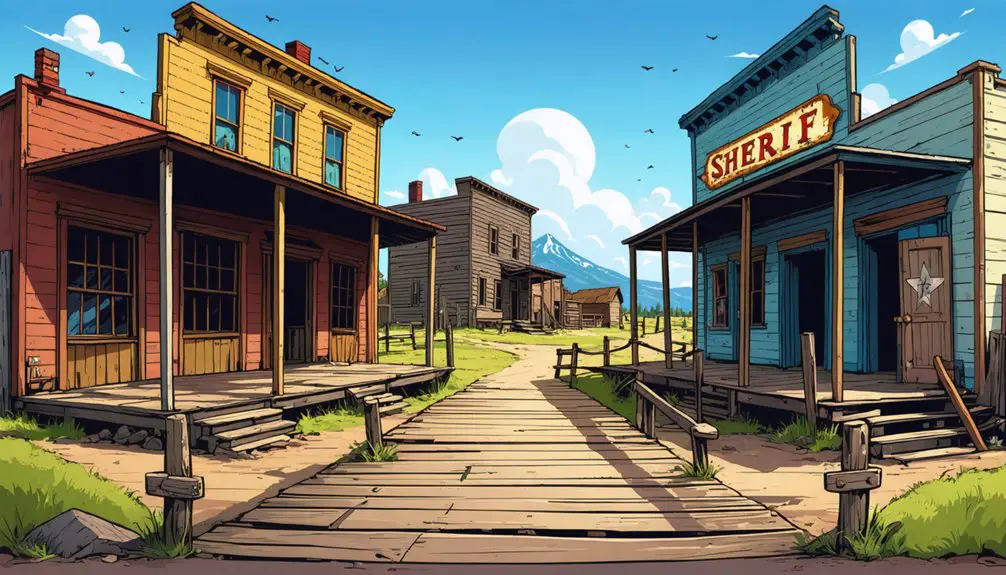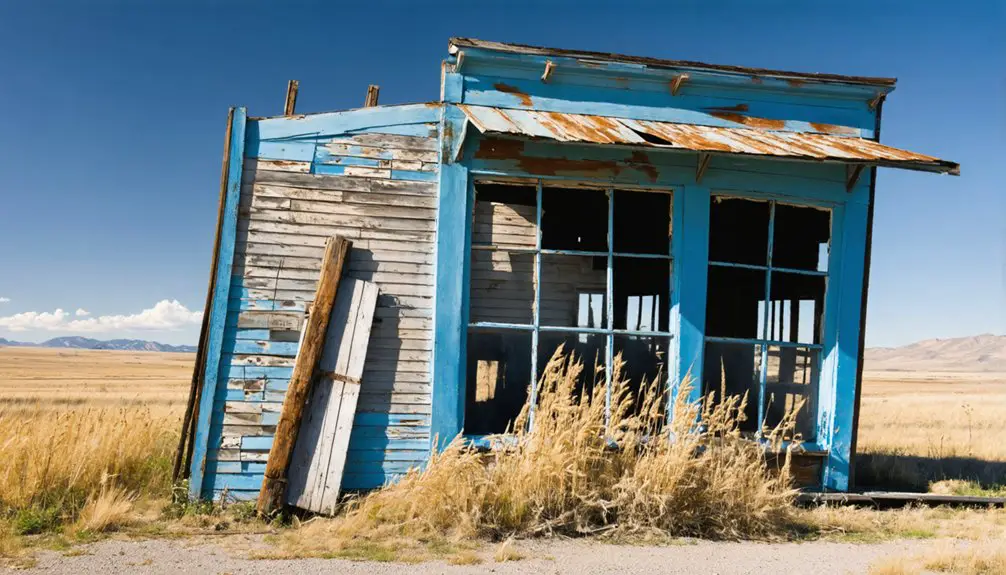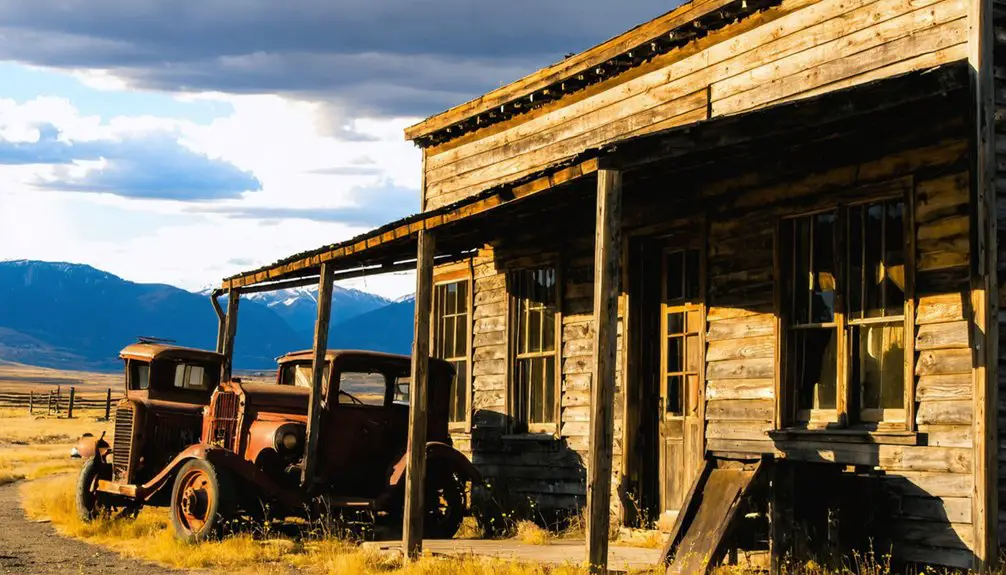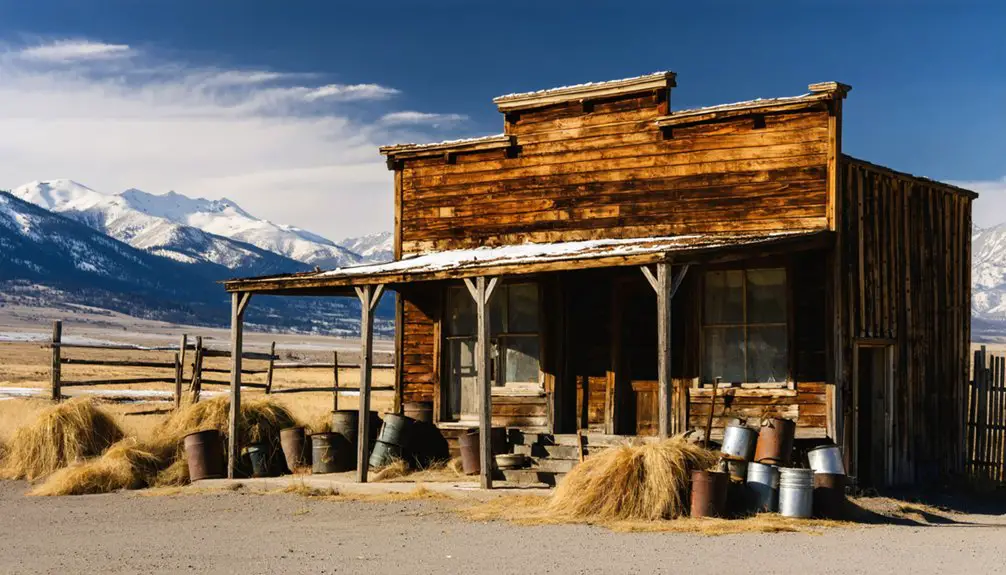You’ll find Corwin’s remnants in southwestern Montana, where silver mining once drove a bustling community in the early 1900s. The town’s log cabins and mining equipment still dot the landscape, telling tales of hardy miners who worked grueling shifts in challenging conditions. While a devastating fire in 1905 and plummeting silver prices led to its decline, Corwin’s preserved ruins offer a fascinating window into Montana’s rich mining heritage and frontier life.
Key Takeaways
- Corwin emerged as a mining hub in Montana during the 1860s, focusing on gold and transitioning from placer to hard rock mining operations.
- The town featured timber-built structures, including saloons, boarding houses, and mining facilities, constructed for quick establishment rather than permanence.
- Founded by Pete Karst in the early 1900s, Corwin attracted skilled miners but faced challenges from harsh winters and mining accidents.
- The town declined after a devastating 1905 fire destroyed its business district, with final closure of the post office in 1921.
- Today, visitors need 4WD vehicles to access the remote site and must follow ghost town etiquette to preserve remaining historical structures.
The Rise of a Mining Settlement
While Montana’s early mining history centered around gold discoveries near Deer Lodge in the 1850s, Corwin’s development emerged from a later wave of prospecting that focused on rich lode deposits.
You’ll find that by the mid-1860s, the area’s mining innovations shifted from simple placer mining to more complex shaft sinking and tunnel driving, revealing valuable veins of silver, gold, and copper.
The settlement patterns followed a familiar trajectory – as prospectors exhausted placer deposits elsewhere, they sought fresh opportunities in Corwin’s promising terrain.
Montana Mining Company’s investment in stamp mills and reduction works proved essential, transforming the remote location into a viable mining hub. The nearby six charcoal kilns supplied the smelting operations with an impressive 25,000 bushels of fuel monthly.
Despite harsh winters and challenging transportation routes, the district’s rich ore attracted substantial national and international capital, fueling sustained growth and development.
Similar to Thomas Cruse’s success with the Drumlummon Mine claim in 1876, early prospectors in Corwin staked their fortunes on promising mineral deposits.
Life During the Boom Years
During Corwin’s boom years, you’d find miners working long, hazardous shifts using dynamite and hand tools while earning wages that sustained the town’s vibrant economy.
After dark, you could join the crowds at multiple saloons and boarding houses where miners swapped stories, gambled, and found relief from their demanding work. The establishments were bustling with activity, much like towns such as Garnet which had thirteen saloons operating during peak times. Cold, damp conditions in the mines meant workers faced serious health hazards from constant exposure to dust and poor air quality.
The social fabric you’d encounter reflected mining culture‘s acceptance of daily risks, with workers forging strong bonds through shared experiences and the inherent dangers of their profession.
Mining Work and Wages
As miners flocked to Corwin’s promising mineral deposits, they faced grueling work conditions that tested both their endurance and expertise.
You’d find them laboring through 8 to 12-hour shifts, performing backbreaking work from placer mining to deep underground extraction. Wage fluctuations were common, with earnings heavily dependent on successful gold discoveries during the early days. The men utilized hydraulic mining equipment extensively, particularly in operations like those documented at Nelson Gulch. Like many mining operations that would later emerge in Treasure State, Corwin’s mines demanded intense physical labor for uncertain rewards.
When operations shifted to hard rock mining, you’d see more structured pay scales emerge, though labor disputes weren’t uncommon as workers demanded fair compensation for increasingly dangerous work.
You’d earn more as a skilled shaft sinker or experienced hard rock miner than as a general laborer. While company stores and housing took their cut from your wages, the promise of striking it rich kept many miners pushing through the harsh conditions.
Social Life After Dark
The hard-earned wages from long days in Corwin’s mines often found their way into the town’s vibrant after-dark social scene.
Mining camaraderie flourished in saloons and boarding houses, where you’d find fellow miners sharing tales of their latest strikes over whiskey and card games. The nightlife traditions centered around these bustling establishments, where music, gambling, and occasional brawls kept the energy high into the early hours. Like in nearby Virginia City and Nevada, these entertainment venues helped sustain a population of thousands during the boom years. With a peak of 500 residents, the town maintained a surprisingly active social calendar for its modest size.
- Saloons served as the primary social hubs, offering card games, live music, and flowing drinks.
- Boarding house gatherings featured informal storytelling and fiddle playing by the fire.
- Hotels’ common rooms hosted everything from casual gatherings to high-stakes poker games.
- Union halls doubled as dance venues during special occasions.
- Brothels and gambling houses drew crowds seeking additional entertainment options.
Daily Operations in the Mines
You’ll find evidence of period-appropriate mining equipment throughout Corwin’s abandoned shaft entrances, including hand drills, picks, and ore carts that were essential to the daily extraction process.
Workers relied heavily on candles and carbide lamps to illuminate their underground workspace while maneuvering through the maze of tunnels and performing physically demanding tasks.
The mines implemented basic safety measures including timber supports and ventilation systems, though accidents remained common due to the inherent dangers of early hard rock mining techniques.
Given the elevation of 5,200 feet, miners had to contend with thin mountain air while conducting their strenuous underground work.
A tragic reminder of mining’s hazards occurred when the Smith Mine explosion killed 73 miners in 1943, marking one of Montana’s worst mining disasters.
Mining Equipment and Tools
Mining operations in Corwin required an extensive array of specialized equipment and tools to extract precious metals from deep underground. The evolution of mining tools transformed from basic picks and shovels to more sophisticated machinery as technology advanced.
- Powerful air compressors drove pneumatic drills that bored holes into the hard rock for blasting.
- Steam-powered hoists and headframes lifted ore and miners through the vertical shafts.
- Stamp mills crushed extracted ore into fine material using heavy metal stamps.
- Mercury amalgamation equipment separated gold from crushed ore.
- Underground rail systems moved ore through the tunnels to processing areas.
You’ll find remnants of this equipment scattered throughout Corwin’s mine sites today. While most machinery was salvaged long ago, some rusted remnants still tell the story of the town’s mining heritage and technological progress.
Worker Safety Protocols
While advanced machinery powered Corwin’s mining operations, worker safety remained a significant challenge throughout the town’s active years.
You’d find basic safety regulations focused on limiting workers in dangerous zones and maintaining strict timetables to reduce nighttime work. Pre-shift meetings occasionally warned of hazards, while rope operators needed constant vigilance to prevent accidents.
Worker health suffered from inadequate protective equipment – typically just leather boots and hats.
You’d see miners facing daily risks of rock falls, shaft collapses, and toxic gas buildups in poorly ventilated tunnels. They relied on canaries and flame lamps to detect dangerous gases.
The mines kept basic rescue tools onsite, but emergency protocols were minimal, and formal rescue teams didn’t exist. Instead, local miners volunteered during emergencies, using voice signals to coordinate response efforts.
Social Scene and Entertainment
As workers descended into Corwin’s mines each day, the town’s vibrant social scene came alive in its numerous saloons and gathering spots.
While miners toiled beneath the earth, Corwin’s surface pulsed with the social rhythms of saloons and meeting halls.
These entertainment venues formed the backbone of social interactions, where miners could escape the harsh realities of their dangerous work.
- Saloons served as the primary meeting places, offering card games, dice, and flowing liquor.
- Live music filled the air as fiddle players and guitarists performed for weather-worn crowds.
- Bawdy houses operated alongside drinking establishments, catering to the mainly male population.
- Community halls hosted dances and holiday celebrations that brought together all social classes.
- Boarding houses doubled as informal gathering spaces where miners shared stories and mining lore.
The ebb and flow of mining fortunes directly influenced the liveliness of these establishments, with boom times bringing new venues and bust periods forcing others to close.
Notable Characters and Stories

Founded by Pete Karst in the early 1900s, Corwin’s colorful cast of characters began with a simple dude ranch that transformed into a bustling mining settlement.
Among the notable figures were skilled miners who’d left depleted claims in California and Colorado, bringing their expertise in gold extraction methods from panning to sluice operations.
Life wasn’t easy for these pioneers. You’ll find tales of their resilience through harsh winters and economic hardships, while entrepreneurs tried their luck opening stores and services.
The town’s history is marked by both triumph and tragedy – from mining accidents to epidemics that struck the community.
Today, their stories live on through local legends, with visitors reporting mysterious sensations around abandoned buildings where these determined souls once lived and worked.
Architecture and Infrastructure
You’ll find Corwin’s buildings were constructed primarily from locally sourced timber and rough-hewn logs, reflecting the hasty development typical of Montana mining settlements in their early days.
The town’s structures lacked permanent foundations, as miners prioritized quick construction of small, easy-to-heat cabins and commercial buildings to support immediate mining operations.
The mining infrastructure included strategically positioned assay offices and equipment storage facilities, which were typically larger framed buildings designed to handle the essential testing of ore quality and storage of mining supplies.
Building Materials and Construction
While Corwin’s buildings reflected the hasty construction typical of Montana mining towns, their architectural features tell a fascinating story of frontier resourcefulness.
You’ll find that log materials dominated the landscape, with builders taking advantage of the abundant timber from surrounding mountainous areas. False fronts transformed simple log structures into more impressive commercial facades, embodying the town’s economic aspirations.
- Log cabins featured brick chimneys for wood stove heating, though many are now deteriorating.
- Buildings often lacked permanent foundations, prioritizing quick construction over longevity.
- Frame false-fronts added height and formality to commercial structures.
- Minimal masonry use due to high costs and difficult transport conditions.
- Adaptable construction methods allowed for easy modification as the town’s needs changed.
Mining Infrastructure Development
The sprawling network of mining infrastructure in Corwin reveals the town’s ambitious industrial scale.
You’ll find evidence of mining innovations in the multi-level tunnel systems that once stretched for miles underground, connected by structural supports and ventilation networks that pushed the boundaries of engineering for their time.
At the heart of Corwin’s operations stood a gravity-fed mill where ore processing conquered significant infrastructure challenges through an intricate system of crushing stations and flotation tanks.
The mill’s concrete foundations and elevated walkways still hint at the industrial sophistication required to process silver ore.
Modern environmental management has transformed the site’s waste rock dumps through strategic reclamation efforts, while surviving transportation infrastructure – from rugged haul roads to bridges – demonstrates how the town overcame its remote location to maintain essential supply lines.
The Town’s Decline

Once silver prices began plummeting in Corwin’s heyday, the town’s fate followed a tragic but familiar pattern seen across Montana’s mining communities.
The town’s economic vulnerabilities became painfully apparent as its singular dependence on mining proved unsustainable. Despite the community’s resilience, you’ll find that several interconnected factors sealed Corwin’s destiny:
- A devastating 1905 fire destroyed the business district, crippling commercial activity
- The last saloon closed in 1918, marking the end of social significance
- The post office shuttered in 1921, severing crucial communication links
- Families steadily departed as businesses closed and jobs vanished
- Failed attempts to revive mining operations in the 1970s proved too little, too late
These compounding challenges transformed a once-thriving settlement into the ghost town you’ll discover today.
Remnants and Ruins Today
Standing amid scattered foundations and weathered timbers, Corwin’s skeletal remains tell a poignant story of Montana’s mining heritage.
You’ll find collapsed log cabins, mining infrastructure, and residential ruins scattered across the high Elkhorn landscape, where harsh mountain weather continues to shape their destiny.
While state preservation efforts since 1980 have helped stabilize key structures, nature steadily reclaims these historic remnants.
You can explore the site’s mining legacy through visible tailings heaps, mill foundations, and processing equipment ruins.
As you navigate the uneven terrain, you’ll discover interpretive signs explaining the town’s past, though visitor safety requires caution around unstable structures and blocked mine entrances.
The site’s isolation and exposure to extreme elements create an authentic, if challenging, ghost town experience.
Historical Significance

Beyond these weathered ruins lies a rich historical legacy that shaped Montana’s mining heritage. As you explore Corwin’s remains, you’ll discover a representation of the untamed spirit of the American frontier and its economic legacy.
Montana’s mining ruins stand as silent witnesses to the untamed frontier spirit that forged the state’s economic foundations.
The town’s story captures the essence of western expansion and mineral exploitation that defined Montana’s development.
- Corwin exemplifies the boom-and-bust cycle that characterized frontier mining communities
- The town’s diverse population contributed to a unique cultural memory of frontier life
- Mining operations here influenced regional economic development during the late 19th century
- The site preserves evidence of period mining techniques and social structures
- Corwin’s remains offer valuable insights into the environmental impact of historical mining practices
These remnants serve as an outdoor classroom, teaching future generations about the determination and resilience of Montana’s mining pioneers.
Visiting the Ghost Town
Although Corwin’s remote location presents challenges for modern visitors, the ghost town’s authentic ruins offer an unfiltered glimpse into Montana’s mining past.
You’ll need a high-clearance vehicle, preferably with 4WD, to navigate the rugged mountain roads leading to the site. Before setting out, gather essential travel tips: pack water, food, and emergency supplies, as there aren’t any services nearby.
Remember proper ghost town etiquette by leaving artifacts undisturbed and photographing rather than collecting souvenirs. The site lacks formal amenities, so you’re responsible for your own safety around unstable structures and uneven terrain.
Consider combining your visit with trips to nearby ghost towns like Bannack or Granite for a thorough Montana mining heritage experience.
Frequently Asked Questions
Were There Any Documented Paranormal Sightings or Ghost Stories in Corwin?
Like a blank canvas waiting for its first brushstroke, you won’t find any documented ghostly encounters or spectral sightings in Corwin. Other Montana ghost towns claim paranormal activity, but Corwin’s spirits remain silent.
What Happened to Valuable Mining Equipment When the Town Was Abandoned?
You’d find that most valuable mining equipment was removed during town abandonment, with miners dismantling and taking reusable pieces. Larger machinery was left behind due to transport difficulties.
Did Any Famous Outlaws or Gunfighters Ever Visit Corwin?
You won’t find any documented famous outlaws or gunfighter legends tied to Corwin. Unlike nearby Bannack and Virginia City, there’s no historical evidence that notorious characters ever visited this remote mining settlement.
How Did Residents Handle Medical Emergencies in Such a Remote Location?
Like wolves tending their pack, you’d rely on neighbors’ first aid skills while organizing emergency transportation by horse to Helena – a grueling multi-day journey when every minute counted.
Were There Any Successful Businesses That Relocated From Corwin to Other Towns?
You won’t find documented evidence of business relocation from Corwin to other towns. Unlike nearby mining communities that saw organized town migration, Corwin’s businesses likely closed rather than successfully moving elsewhere.
References
- https://www.meeteetsewy.com/places-to-visit/kirwin-ghost-town-wyoming
- https://destinationmissoula.org/ghost-towns
- https://www.garnetghosttown.org/history.php
- https://southwestmt.com/blog/ghost-town-terror-gunslinger-gulch/
- https://www.youtube.com/watch?v=cRyjmHe8z-4
- https://mhs.mt.gov/education/textbook/chapter6/Chapter6.pdf
- https://archiveswest.orbiscascade.org/ark:/80444/xv28731
- https://westernmininghistory.com/towns/montana/wickes/
- https://npshistory.com/publications/usfs/region/1/flathead/history/chap3.htm
- https://archiveswest.orbiscascade.org/ark:80444/xv647063



